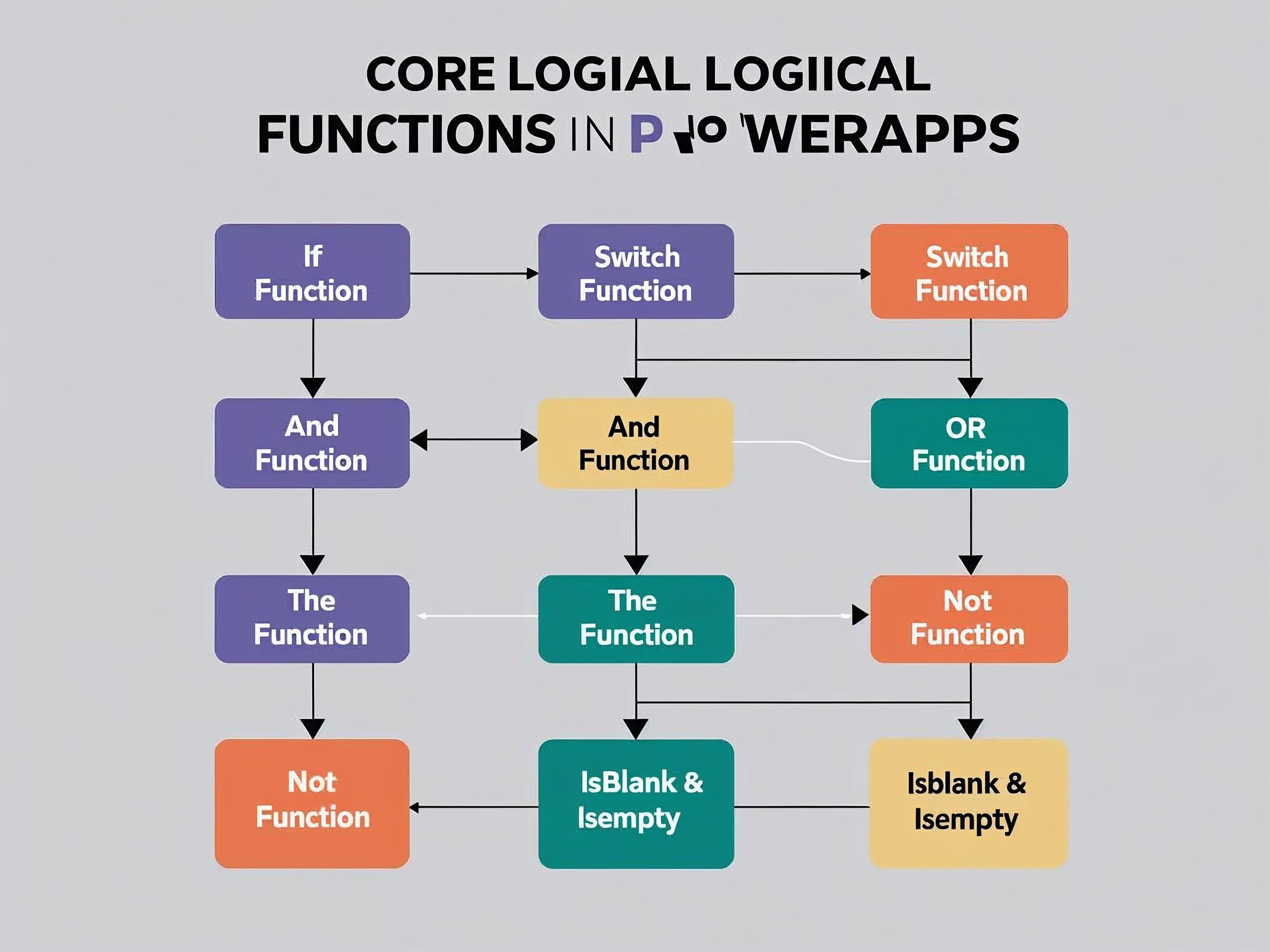✅Logical Functions in PowerApps: A Complete Guide
1. Introduction Logical Functions in PowerApps
Core Logical Functions in PowerApps play a critical role in decision-making, validation, conditional rendering, and business rule implementation. Whether you’re building a simple form or a complex enterprise app, using Core Logical Functions in PowerApps is essential for defining how your app behaves under different scenarios.
PowerApps, a low-code development platform, empowers both citizen developers and professional programmers to build interactive and intelligent applications. Logical functions are the foundation that allows apps to “think” and respond dynamically to user inputs or system data.
Core Logical Functions in PowerApps: A Complete Guide
Here’s a comprehensive overview of Logical Functions in PowerApps, organized for easy understanding and reference. You can also check the reference here
Table of Contents- Logical Functions in PowerApps
- Introduction
- Why Logical Functions Matter in PowerApps
- Overview
- 3.1 If Function
- 3.2 Switch Function
- 3.3 And Function
- 3.4 Or Function
- 3.5 Not Function
- 3.6 IsBlank & IsEmpty Functions
- 3.7 Coalesce Function
- If Function: The Most Common Logical Operator
- Switch Function: Handling Multiple Conditions
- And, Or, and Not Functions: Boolean Logic Simplified
- Handling Null and Empty Values with IsBlank, IsEmpty, and Coalesce
- Combining Logical Functions for Complex Conditions
- Practical Use Cases
- Tips for Using Core Logical Functions Efficiently
- Common Mistakes and How to Avoid Them
- Conclusion

2. Why Logical Functions Matter in PowerApps
The ability to control flow, define rules, and adapt interfaces dynamically is what makes an app smart and user-friendly. Logical functions make that possible. From showing/hiding fields to validating user input and creating dynamic screens.
- Increased interactivity and usability
- Enhanced data validation
- Smart workflows and user decisions
- Optimized screen transitions and rendering logic
3. Overview of Key Logical Functions in PowerApps
3.1 If Function
Executes different code blocks based on true/false conditions.
3.2 Switch Function
Alternative to nested Ifs; evaluates expressions against multiple possible values.
3.3 And Function
Returns true only if all conditions are true.
3.4 Or Function
Returns true if at least one condition is true.
3.5 Not Function
Negates a Boolean expression.
3.6 IsBlank & IsEmpty
Checks for null, blank, or empty values.
3.7 Coalesce Function
Returns the first non-blank value from a list of expressions.
4. If Function: The Most Common Logical Operator
It evaluates a condition and executes logic based on whether the condition is true or false.
Syntax:
If( Condition, ThenResult [, ElseResult] )
Example:
If( txtAge.Text > 18, "Eligible", "Not Eligible" )
You can also nest If() statements:
If(
txtScore.Text > 90, "A",
txtScore.Text > 75, "B",
txtScore.Text > 50, "C",
"Fail"
)
Use Cases:
- Field validation
- Displaying conditional messages
- Controlling screen navigation
5. Switch Function: Handling Multiple Conditions- Logical Functions in PowerApps
It’s perfect when you want to evaluate a single expression against multiple values.
Syntax:
Switch( Formula, Match1, Result1 [, Match2, Result2, ..., DefaultResult] )
Example:
Switch(
drpDepartment.Selected.Value,
"HR", "Human Resources",
"IT", "Information Technology",
"FIN", "Finance",
"Unknown Department"
)
Advantages over If():
- Cleaner code when handling many options
- Easier to maintain
- Reduces nesting complexity
6. And, Or, and Not Functions: Boolean Logic Simplified- Logical Functions in PowerApps
And Function
And( Condition1, Condition2 )
Or Function
Or( Condition1, Condition2 )
Not Function
Not( Condition )
Example:
If( And(Slider1.Value > 10, Toggle1.Value = true), "Valid", "Invalid" )
You can mix these for complex scenarios:
If( Or(txtName.Text = "", Not(Toggle1.Value)), "Incomplete", "Complete" )
7. Handling Null and Empty Values with IsBlank, IsEmpty, and Coalesce- Logical Functions in PowerApps
Managing empty values is a key part of logic in apps.
IsBlank()
Checks if a value is null or blank.
IsBlank(txtEmail.Text)
IsEmpty()
Checks if a collection or table is empty.
IsEmpty(colEmployees)
Coalesce()
Returns the first non-blank value.
Coalesce(txtEmail.Text, "no-email@domain.com")
8. Combining Logical Functions for Complex Conditions
In real-world apps, combining multiple logical functions is crucial.
Example:
If(
And(
!IsBlank(txtName.Text),
Or(Switch1.Value, Switch2.Value)
),
"Ready",
"Incomplete"
)
You can nest:
If()withAnd(),Or()Coalesce()withIsBlank()Switch()withIf()
This pattern allows your app to model business rules, validations, and conditional workflows effectively.
9. Practical Use Cases of Core Logical Functions in PowerApps
A. Show/Hide Fields
Visible: If(drpRole.Selected.Value = "Admin", true, false)
B. Conditional Formatting
Fill: If(Slider1.Value > 80, Red, Green)
C. Navigation Control
If(IsBlank(txtUsername.Text), Notify("Username required"), Navigate(HomeScreen))
D. Data Validation
If(
Or(IsBlank(txtEmail.Text), !IsMatch(txtEmail.Text, EmailPattern)),
Notify("Enter valid email")
)
10. Tips for Using Core Logical Functions Efficiently
- Use Switch over nested Ifs when matching a single variable.
- Avoid deep nesting; break complex logic into variables.
- Use
Coalesce()to simplify null checks. - Use
Set()andUpdateContext()to store results and reuse logic. - Always test for blank and empty values especially when working with forms or data sources.
11. Common Mistakes and How to Avoid Them
- Using If instead of Switch: Makes the code messy and harder to debug.
- Not checking for null/blank values: Can crash the app or lead to logical errors.
- Overusing nested Ifs: Reduces maintainability.
- Forgetting to use parentheses: Especially in
And()orOr()expressions. - Incorrect use of
Not(): Can lead to inverse logic errors if not carefully applied.
12. Conclusion
Core functions are foundational for building dynamic, responsive, and intelligent applications. From basic If() statements to advanced combinations involving Switch(), And(), Or(), and Coalesce(), these functions let you embed decision-making logic directly into your app interfaces.
- Build smarter business apps
- Implement real-time validation and decision logic
- Maintain clean and scalable code
- Improve the user experience dramatically
